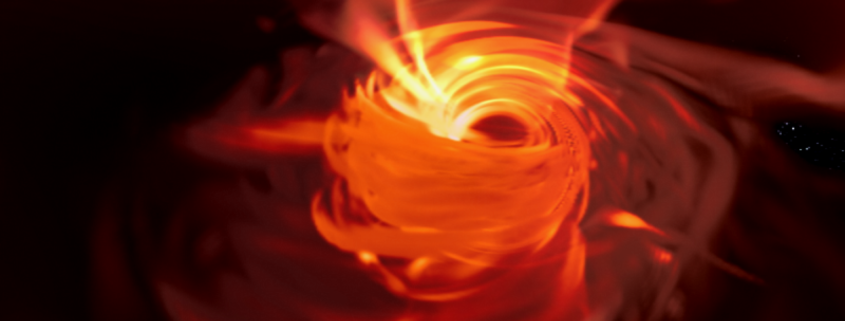At the centre of our own galaxy there is a black hole, called Sagittarius A*. In anticipation of the first actual photograph of a black hole, an international project involving astronomers of BlackHoleCam, Jordy Davelaar and colleagues have built a virtual reality (VR) simulation of the phenomenon. The VR simulation was published in Computational Astrophysics and Cosmology on November 19th. We asked him two questions about this simulation.
Credits: Jordy Davelaar, Thomas Bronzwaer, Daniel Kok, Ziri Younsi, Monika Moscibrodzka and Heino Falcke. Music: Thomas Bronzwaer
What exactly are we seeing in the simulation?
‘In the simulation you move around the black hole at the centre of our galaxy. The light you see comes from matter that disappears into the black hole in a vortex-like way; due to the extreme conditions it becomes a plasma that starts to glow. This light is then deflected and deformed by the powerful gravity of the black hole. Some of the plasma is ejected away from the black hole in a jet stream at very high velocity. You can see the path that a particle could take in such a plasma flow; it moves continually inwards in a spiral trajectory until it is ejected in the jet stream.’
Why do you think Sagittarius A* looks like this?
‘The purpose of the simulation is to make the most realistic possible representation of the direct environment of Sagittarius A*. The camera calculates at every point what the environment would look like if we were able to see radio-emissions. To do this we used models that were developed in part by Nijmegen astronomers and radio telescope observations.
In our coding for the simulation, we used Einstein’s General Theory of Relativity. This enabled us to visualize all the effects you would experience when you move around a black hole, such as light deflection, the distortion of your field of view due to your speed. This provides the most realistic possible experience of what we think this environment is like. The simulation is unique and is even more realistic than the visualizations in the film “Interstellar”.’
Publication
Observing Supermassive Black Holes In Virtual Reality, Computational Astrophysics and Cosmology, Jordy Davelaar, Thomas Bronzwaer, Daniel Kok, Ziri Younsi, Monika Moscibrodzka and Heino Falcke. https://comp-astrophys-cosmol.springeropen.com/articles/10.1186/s40668-018-0023-7
The research was made possible by the ERC Synergy grant titled ‘BlackHoleCam’ given to Heino Falcke (Radboud University), M. Kramer (Max Planck Institute for Radioastronomy), L. Rezzolla (Goethe University Frankfurt).
More information? Please contact
Jordy Davelaar, j.davelaar@astro.ru.nl, +31 24 365 3206 or +31 6 10 00 39 65
Science communication Radboud University, +31 24 361 6000, media@ru.nl.
Radboud University stimulates its leading research areas. Astrophysics is one of them.
This press release was originally posted at https://www.ru.nl/english/news-agenda/news/vm/imapp/astrophysics/2018/flying-past-black-hole-simulator/






